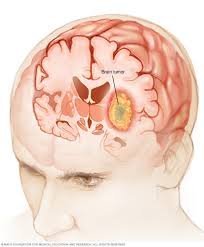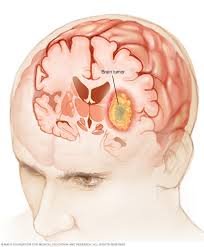Best Guide Brain tumors in 2025
Brain Tumors: Types, Symptoms, Diagnosis, and Treatment
Introduction
Brain tumors are abnormal growths within the central nervous system (CNS) that can originate from various cells, including neurons, glial cells, myelin-producing oligodendrocytes, ependymal cells, meninges, and glandular structures like the pituitary and pineal glands.
Primary Brain Tumors
Brain tumors are typically named after the cells of origin:
- Astrocytoma – Arises from astrocytes
- Oligodendroglioma – Originates from oligodendrocytes
- Ependymoma – Develops from ependymal cells (CSF-producing cells)
- Neuroblastoma – A tumor of neuronal origin
- Glioblastoma Multiforme (GBM) – Highly aggressive glial tumor
- Pinealoma – Arises from the pineal gland
- Pituitary Adenoma – Affects the pituitary gland
- Craniopharyngioma – Originates from Rathke’s pouch near the hypothalamus
- Meningioma – Develops from the meninges
- Schwannoma (Acoustic Neuroma) – Affects Schwann cells of cranial nerves
Brain Tumors: Gender and Age Prevalence
Gender Differences
Brain tumors are generally more common in males than females. However, two notable exceptions—meningiomas and schwannomas—occur more frequently in females. These tumors are also located outside the brain, making them more accessible for surgical removal, which improves prognosis.
Age-Wise Distribution
- Adults: Tumors are predominantly supratentorial (above the cerebellum), affecting the frontal lobe.
- Children: Tumors are more common in the infratentorial region (below the cerebellum).
Common Pediatric Brain Tumors (in order of frequency)
- Cerebellar Astrocytoma (Cerebellar hemispheres)
- Medulloblastoma (Cerebellar vermis)
- Ependymoma (4th ventricle, typically in 4-year-olds)
In adults, the most common brain tumor is Glioblastoma Multiforme (GBM), often found in the frontal lobe.
Brain Tumor Locations and Their Clinical Features
Tumor Locations and Their Names
Most brain tumor locations can be predicted based on their name:
- Pituitary Adenoma – Located in the pituitary fossa
- Pinealoma – Found posterior to the upper midbrain
- Ependymoma – Often in the 4th ventricle, leading to obstructive hydrocephalus
- Meningioma – Near skull bones
- Schwannoma (Acoustic Neuroma) – Affects the 8th cranial nerve (vestibulocochlear nerve)
- Craniopharyngioma – Found near the hypothalamus
- Medulloblastoma – Located in the cerebellar vermis, close to the medulla
If the tumor’s name does not indicate a specific location (e.g., glioblastoma, astrocytoma, oligodendroglioma), the most common site is:
- Frontal lobe in adults
- Cerebellum in children
Symptoms of Brain Tumors
General Symptoms
- Headaches (worse in the morning)
- Nausea & vomiting (due to increased intracranial pressure)
- Seizures
- Cognitive & personality changes
- Focal neurological deficits (weakness, vision changes, speech difficulties)
Tumor-Specific Symptoms
- Ependymoma (4th ventricle) → Obstructive hydrocephalus
- Pinealoma → Parinaud’s syndrome (vertical gaze palsy due to midbrain compression)
- Pituitary/Hypothalamic tumors → Hormonal imbalances
- Glioblastoma Multiforme (GBM) → Rapidly worsening symptoms due to aggressive growth & necrosis
- Sudden tumor hemorrhage can mimic a stroke (CVA).
Brain Tumor Growth & Metastasis
Growth Pattern
- Most brain tumors are slow-growing, so necrosis is uncommon.
- Exception: GBM grows rapidly, leading to necrosis and bleeding.
- GBM can spread across the corpus callosum, giving a butterfly appearance on imaging.
Metastasis
- Brain tumors rarely metastasize outside the CNS.
- Instead, they spread within the brain and cerebrospinal fluid (CSF).
Brain Lymphoma in Immunocompromised Patients
Patients with HIV/AIDS or those undergoing chemotherapy may develop primary CNS lymphoma, particularly B-cell lymphoma in the periventricular area.
Diagnosis of Brain Tumors
Imaging Techniques
- CT Brain (CTB) – First-line imaging for suspected tumors
- MRI Brain – Best modality for tumor localization & characterization
- Contrast Enhancement – Helps differentiate tumor types
- Biopsy – Occasionally needed for definitive diagnosis
Treatment of Brain Tumors
1. Surgery (Primary Treatment)
- Preferred option if the tumor is accessible and the patient is fit for surgery.
- Meningioma & schwannoma are often completely removed due to their favorable location.
2. Radiation Therapy
- Used when surgical removal is incomplete or not possible.
- Targeted radiotherapy is particularly beneficial for GBM and metastatic tumors.
3. Chemotherapy
- Less effective in most brain tumors due to the blood-brain barrier (BBB).
- Temozolomide is a chemotherapy drug used for GBM treatment.
Metastatic Brain Tumors
Overview
- The brain is a common site for metastasis from other cancers (e.g., lung, breast, melanoma).
- Metastases often occur at the gray-white junction due to high vascularity.
Key Features of Metastatic Tumors
- Multiple lesions are common, but single metastases can also occur.
- Less likely to have necrosis or calcification (compared to primary brain tumors).
- Patients often have cachexia (weight loss, fatigue), which is rare in primary brain tumors.
Diagnosis & Management
- MRI with contrast is essential for detecting metastases.
- If the primary tumor is unknown, whole-body PET scans or biopsy may be needed.
- Palliative care is often the main approach due to poor prognosis.
Conclusion
Brain tumors vary in location, symptoms, and treatment approaches. Early diagnosis with neuroimaging and appropriate surgical or radiotherapy treatment can improve outcomes. Glioblastoma (GBM) remains the most aggressive brain tumor, whereas meningioma and schwannoma have better prognosis.


4 Responses
[…] What is Stroke? […]
[…] Brain Tumors: Types, Symptoms, Diagnosis, and Treatment on A Medical Guide of Status Epileptics!March 3, 2025 […]
[…] Brain Tumors: Types, Symptoms, Diagnosis, and Treatment on A Medical Guide of Status Epileptics!March 3, 2025 […]
[…] Brain Tumors: Types, Symptoms, Diagnosis, and Treatment on A Medical Guide of Status Epileptics!March 3, 2025 […]